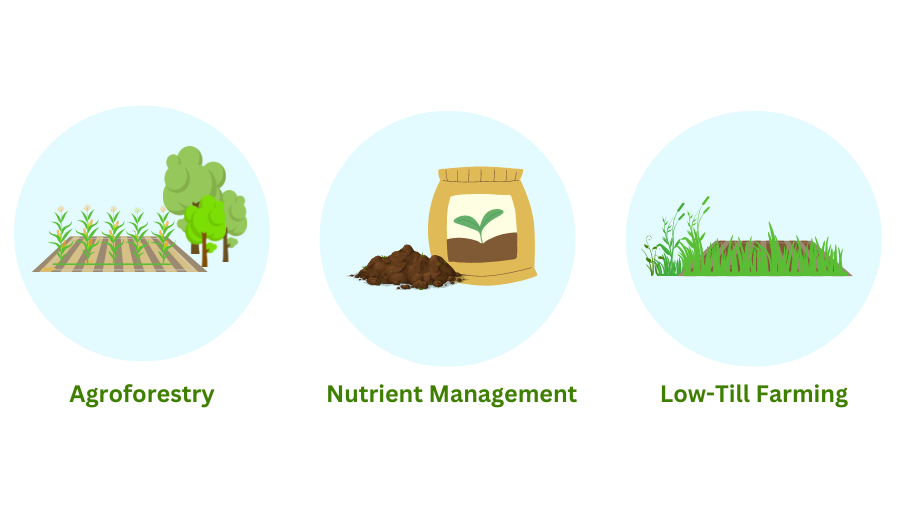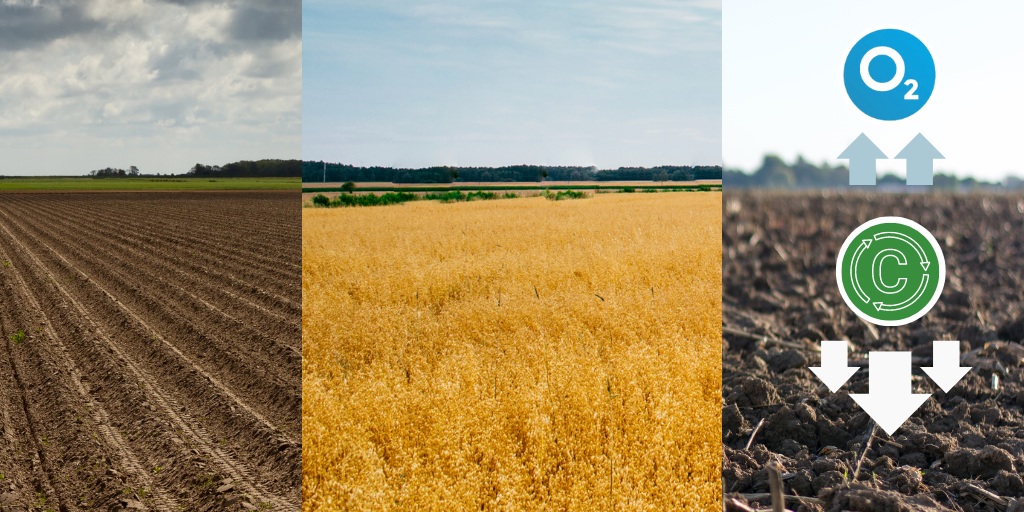Carbon capture and sequestration (CCS) is a hot topic among growers right now as a promising tool in the fight against climate change. In many ways, agriculture is an industry uniquely positioned to make a real difference with minimal changes to existing processes. In Canada, the Federal government has committed to achieving net-zero carbon emissions by 2050. Globally, the agricultural sector is responsible for 9% of greenhouse gas emissions, but farms and especially orchards have the potential to be used more efficiently to capture and hold carbon.
In agriculture, net zero emissions may be closer than we think. It is a fact that greenhouse gas emissions contribute to climate change, but what do we mean when we talk about “greenhouse gasses”, specifically? The key gasses of concern when it comes to climate change are nitrous oxide, methane, and carbon dioxide. In agriculture, the emission of greenhouse gasses comes primarily from livestock, but fruit and vegetable growers can also take steps to reduce their carbon emissions.
Benefits of CCS:
Carbon capture and sequestration can bring a range of benefits to farmers, including economic, environmental, and social benefits. By taking an active role in mitigating climate change, farmers can secure a better future for themselves and their communities. There are several ways growers can benefit from carbon capture and sequestration:
- Increased Soil Health: By implementing sustainable farming practices that encourage carbon sequestration, farmers can improve soil health, which in turn can lead to better crop yields, increased water retention, and improved soil structure.
- Climate Resilience: By reducing greenhouse gas emissions and sequestering carbon, farmers can play a critical role in mitigating the impacts of climate change, and can make their farms and communities more resilient to the impacts of a changing climate.
- Enhanced Reputation: By implementing environmentally sustainable practices, farmers can enhance their reputation and differentiate themselves from their competitors in the marketplace.
- Policy Support: Governments are increasingly recognizing the role that agriculture can play in mitigating climate change and are offering incentives and support for farmers who implement carbon capture and sequestration practices.
So how does CCS work?
The carbon cycle refers to the bio-geo-chemical processes that move carbon from the earth through the atmosphere and environment. Carbon is stored naturally in the earth; when an area’s carbon storage is greater than its carbon output, it is considered a “carbon sink”. Carbon sinks can be natural or artificial reservoirs that absorb and store carbon dioxide. There are two main types of carbon sinks: terrestrial sinks and ocean sinks. Terrestrial carbon sinks can include forests, wetlands, and soils. Soil and earth bond with carbon, and as plants grow in the soil carbon dioxide is converted into oxygen through photosynthesis. Orchards, with permanent crops, large quantities of trees, and large areas of relatively undisturbed soil can make ideal carbon sinks. Fields also have potential to act as carbon sinks., However, many standard growing practices can disrupt potential carbon sinks and release stored carbon into the atmosphere.
Carbon smart farming makes use of a farm’s existing natural resources and potential to reduce or offset emissions from production. Best Management Practices (BMPs) are essentially production practices that can improve carbon capture. Generally these are practices that reduce soil disruption, prevent erosion, plant trees and promote long-term root growth, and manage or recycle nutrients in the soil with reduced chemical applications. Let’s take a look at some of the best management production practices that modern growers are using to develop carbon smart farms for the future.

Best Management Practices for CCS
- Nutrient Management: Fertilizer Efficiency
Spray management, timing and using the right amount of fertilizer at the right time helps to reduce fertilizer runoff and emissions of nitrogen compounds. Additionally, using compost and manure can help to sequester carbon in the soil. Even slight changes to fertilizer application patterns can have a big impact.
- Nutrient Management: Side Dress Application:
Side-dress application is a method of fertilizer application in which the fertilizer is applied to the side of the crop row rather than being incorporated into the soil prior to planting. This method is often used for row crops, such as corn and soybeans, and is designed to provide the plants with the nutrients they need for growth at the right time. By applying the fertilizer directly to the side of the row, side-dress application reduces fertilizer losses due to runoff, which can help to improve fertilizer efficiency. Side-dress application also eliminates the need for tillage since the fertilizer is not incorporated into the soil. This can reduce soil disturbance and improve soil health by maintaining soil structure and reducing erosion.
- No-till Farming:
No-till farming is a method of farming where the soil is not disturbed through tillage, meaning that it is not plowed or otherwise disturbed prior to planting. This practice helps to maintain soil structure, reduce erosion, and improve soil health by keeping the soil covered with crop residue or other organic matter. By reducing the amount of tillage, no-till farming helps to maintain the carbon sink effect of the undisturbed soil.
- Crop Rotation:
Rotating crops can help to improve soil health and reduce the need for fertilizer applications. For example, legume crops can fix nitrogen in the soil, reducing the need for nitrogen fertilizers.
- Cover Cropping:
Cover crops can help to improve soil health, reduce erosion, and improve water retention. They can also help to reduce greenhouse gas emissions by absorbing nitrogen compounds before they can be released into the atmosphere. Cover cropping often goes hand in hand with no-till farming, and also helps with weed management.
- Agroforestry: Windbreaks
Windbreaks are rows of trees or shrubs planted along the edge of a field or property to reduce wind speed and increase wind stability. Windbreaks can help to protect soil health by reducing soil erosion and wind damage to crops, which can help to maintain soil carbon levels. The trees and shrubs in windbreaks absorb and store carbon through photosynthesis, helping to reduce atmospheric carbon levels.
- Agroforestry: Buffer strips and intercropping
Buffer strips are areas of vegetation that are planted along the edge of fields or along waterways to protect against soil erosion and nutrient runoff. Intercropping with trees involves planting trees in between rows of crops in a field. These practices both help to sequester carbon by providing additional carbon storage through the trees and by promoting soil health, which can increase the soil's ability to store carbon.
The agricultural sector has a significant role to play in mitigating the impacts of climate change through carbon capture and sequestration. By implementing some of these practices, farmers can help to reduce atmospheric carbon levels and support the health of their soil, which can in turn improve crop yields and contribute to a more sustainable and resilient agriculture sector. Croptracker’s integrated farm management software helps growers manage fertilizer and chemical applications, and track best management practices and labor. Ultimately, the adoption of these practices will play a crucial role in achieving net-zero carbon emissions and addressing the challenges of climate change.
Croptracker develops agtech solutions for industry leaders. Located in Eastern Ontario, Canada, our mission is to make crop production safer, more efficient, and more profitable. Designed in partnership with fresh market producers and distributors, every tool we create is based on direct industry feedback. Croptracker’s award-winning farm software optimizes recordkeeping, labor tracking, production and cost management. Our integrative Harvest Quality Vision technology offers instant empirical analysis of crop samples exactly when you need it. Optimize your harvest season with Croptracker’s customizable solutions. Visit Croptracker.com to learn more about our products and to contact us about app based solutions.


